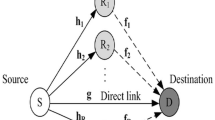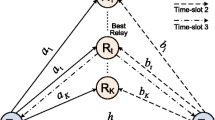Abstract
In this paper, the performance of space shift keying (SSK) modulation is investigated in a cooperative communication system, using incremental decode-and-forward (IDF) and selective decode-and-forward (SDF) relays. The IDF and SDF relays use instantaneous signal-to-noise ratio (SNR) to verify the quality of received signal, which is not applicable to SSK modulation. In addition to instantaneous SNR, channel coefficients play the main role in the performance of SSK modulation. Moreover, in this modulation scheme, the active channel coefficient is unknown. In this paper, instead of instantaneous SNR, a new reliable criterion is introduced to be used in the IDF or SDF protocols for SSK modulation. This criterion is based on the Euclidean distances between active channel coefficient and other inactive channel coefficients. The analytical expressions are derived to calculate the average bit error rate (ABER) and the power consumptions in a cooperative system, over Rayleigh fading channels, for both IDF and SDF relaying protocols. There is good agreement between the Monte Carlo simulated and analytical results. These results show that this Euclidean distance-based criterion, in IDF or SDF relaying protocols, improves cooperative diversity gain and the ABER performance significantly.








Similar content being viewed by others
References
Chau, Y., and Yu, S.-H. (2001). Space modulation on wireless fading channels, IEEE VTS 54th Vehicular Technology Conference, VTC 2001 Fall, Vol. 3, pp. 1668–1671.
Di Renzo, M., Haas, H., & Grant, P. M. (2011). Spatial modulation for multiple-antenna wireless systems: A survey. IEEE Communications Magazine, 49(12), 182–191.
Di Renzo, M., Haas, H., Ghrayeb, A., Sugiura, S., & Hanzo, L. (2014). Spatial modulation for generalized mimo: Challenges, opportunities, and implementation. Proceedings of the IEEE, 102(1), 56–103.
Laneman, J., Tse, D., & Wornell, G. W. (2004). Cooperative diversity in wireless networks: Efficient protocols and outage behavior. IEEE Transactions on Information Theory, 50(12), 3062–3080.
Ikki, S. & Ahmed, M. (2008). Performance analysis of incremental relaying cooperative diversity networks over rayleigh fading channels. In IEEE Wireless Communications and Networking Conference, WCNC 2008, pp. 1311–1315
Chen, H., Liu, J., Zhai, C. & Liu, Y. (2009). Performance of incremental-selective decode-and-forward relaying cooperative communications over rayleigh fading channels. In WCSP 2009 International Conference on Wireless Communications Signal Processing, pp. 1–5.
Mesleh, R., Ikki, S., & Alwakeel, M. (2011). Performance analysis of space shift keying with amplify and forward relaying. IEEE Communications Letters, 15(12), 1350–1352.
Yang, D., Xu, C., Yang, L. L., & Hanzo, L. (2011). Transmit-diversity-assisted space-shift keying for colocated and distributed/cooperative mimo elements. IEEE Transactions on Vehicular Technology, 60(6), 2864–2869.
Mesleh, R., Ikki, S. & Alwakeel, M. (2012). On the performance of dual-hop space shift keying with single amplify-and-forward relay. In 2012 IEEE Wireless Communications and Networking Conference (WCNC), pp. 776–780.
Wen, M., Cheng, X., Poor, H., & Jiao, B. (2014). Use of ssk modulation in two-way amplify-and-forward relaying. IEEE Transactions on Vehicular Technology, 63(3), 1498–1504.
Narayanan, S., Di Renzo, M., Graziosi, F. & Haas, H. (2013). Distributed spatial modulation for relay networks. In 2013 IEEE 78th Vehicular Technology Conference (VTC Fall), pp. 1–6.
Yang, Y., & Aissa, S. (2011). Information-guided transmission in decode-and-forward relaying systems: Spatial exploitation and throughput enhancement. IEEE Transactions on Wireless Communications, 10(7), 2341–2351.
Ma, N., Wang, A., Ji, Y., & Shi, H. (2014). Cooperative space shift keying for multiple-relay network. IEEE Communications Letters, 18(4), 712–715.
Som, P. & Chockalingam, A. (2013). Ber analysis of space shift keying in cooperative multi-hop multi-branch df relaying. In 2013 IEEE 78th Vehicular Technology Conference (VTC Fall), pp. 1–5.
Som, P., & Chockalingam, A. (2015). Performance analysis of space-shift keying in decode-and-forward multihop mimo networks. IEEE Transactions on Vehicular Technology, 64(1), 132–146.
Serafimovski, N., Sinanovic, S., Di Renzo, M. & Haas, H. (2011). Dual-hop spatial modulation (dh-sm). In 2011 IEEE 73rd Vehicular Technology Conference (VTC Spring), pp. 1–5.
Stavridis, A., Sinanovic, S., Di Renzo, M. & Haas, H. (2012). A power saving dual-hop architecture based on hybrid spatial modulation. In 2012 Conference Record of the Forty Sixth Asilomar Conference on Signals, Systems and Computers (ASILOMAR), pp. 1366–1370.
Xie, X., Zhao, Z., Peng, M., Wang, W. (2012). Spatial modulation in two-way network coded channels: Performance and mapping optimization. In 2012 IEEE 23rd International Symposium on Personal Indoor and Mobile Radio Communications (PIMRC), pp. 72–76.
Narayanan, S., Di Renzo, M., Graziosi, F. & Haas, H. (2012). Distributed space shift keying for the uplink of relay-aided cellular networks. In 2012 IEEE 17th International Workshop on Computer Aided Modeling and Design of Communication Links and Networks (CAMAD), pp. 130–134.
Mesleh, R., & Ikki, S. (2013). Performance analysis of spatial modulation with multiple decode and forward relays. IEEE Wireless Communications Letters, 2(4), 423–426.
Som, P., & Chockalingam, A. (2014). Bit error probability analysis of ssk in df relaying with threshold-based best relay selection and selection combining. IEEE Communications Letters, 18(1), 18–21.
Sugiura, S., Chen, S., Haas, H., Grant, P. M., & Hanzo, L. (2011). Coherent versus non-coherent decode-and-forward relaying aided cooperative space-time shift keying. IEEE Transactions on Communications, 59(6), 1707–1719.
Som, P. & Chockalingam, A. (2013). End-to-end ber analysis of space shift keying in decode-and-forward cooperative relaying. In 2013 IEEE Wireless Communications and Networking Conference (WCNC), pp. 3465–3470.
Author information
Authors and Affiliations
Corresponding author
Appendices
Appendix 1
In this Appendix, it is proved that, for \(N_{t}>2\), one of the \(x_{min,1}\) or \(x_{min,2}\) equals \(\left| n \right| ^{2}\) with high probability, where n is the noise of the received signal. Assume that \(x_{min}\) is a vector with the elements of \(x_{min,q}\) which are the values of \(d_{i}\)’s in increasing order, where \(q=1,2,\ldots ,N_{t}\). The probability that \(x_{min,1}=\left| n \right| ^{2}\) is equal to the correct detection probability by optimum detector and is obtained as
Using the probability theory, the probability that \(x_{min,2}=\left| n \right| ^{2}\) is calculated by
Therefore, using the probability theory, the general expression of the probability \(Pr\left( x_{min,q}=\left| n \right| ^{2} \right)\) is derived as
It should be noted that the probability that \(x_{min,1}=\left| n \right| ^{2}\) or \(x_{min,2}=\left| n \right| ^{2}\) is equal to \(\left[ Pr\left( x_{min,1}=\left| n \right| ^{2} \right) +Pr\left( x_{min,2}=\left| n \right| ^{2} \right) \right]\). It is obvious from (44) that \(Pr\left( x_{min,q}=\left| n \right| ^{2} \right)\) decreases more with increasing q. For \(q>2\) and \(\rho _{s}> 10\) dB, the value of \(Pr\left( x_{min,q}=\left| n \right| ^{2} \right)\) is negligible in (44), in comparison to the value of \(\left[ Pr\left( x_{min,1}=\left| n \right| ^{2} \right) +Pr\left( x_{min,2}=\left| n \right| ^{2} \right) \right]\). Therefore, with high probability one of the \(x_{min,1}\) or \(x_{min,2}\) is equal to \(\left| n \right| ^{2}\).
Appendix 2
In this Appendix, the error probability is derived for SSK modulation with \(N_{t}>2\) transmit antennas. Assume the received signal is \(y_{sd}\) as presented in (2). The error takes place at the destination detector when
For large values of \(\rho _{s}\), the term of \(\frac{n_{sd}}{\sqrt{\rho _{s}}}\) is negligible in (45). Then, the right side of (45) is approximated as \(\rho _{s} \mathop {\min }\limits _{i}\left\{ \left| h_{t}-h_{i} \right| ^{2} \right\}\). We define w and y as \(w=\left| n_{sd} \right| ^{2}\) and \(y=\mathop {\min }\limits _{i}\left\{ \left| h_{t}-h_{i} \right| ^{2} \right\}\). As mentioned before in Sect. 3, y is a random variable with PDF given in (26) and w is an exponential random variable with mean \(N_{0}\). Therefore, the ASER at the destination is obtained as
where \(\overline{\gamma }=\sigma _{h}^{2}\rho _{s}/N_{0}\) is the average received SNR.
Appendix 3
In this Appendix, we want to derive the error probability presented in (35). Using optimum detection, an error will take place at the destination when \(\left| n_{sd} \right| ^{2}+\left| n_{r_{j}d} \right| ^{2}>\mathop {\min }\limits _{i=1,\ldots ,N_{t} } \left\{ \left| y_{sd}-\sqrt{\rho }g_{i} \right| ^{2}+\left| y_{r_{j}d}-\sqrt{\rho }f_{j,i} \right| ^{2} \right\}\). We define w as \(w=\left| n_{sd} \right| ^{2}+\left| n_{r_{j}d} \right| ^{2}\). The random variable w is sum of two independent exponential random variables with variances of \(N_{0}\). The PDF of w is obtained as
As mentioned before, the value of \(\mathop {\min }\limits _{i} \left\{ \left| y_{sd}-\sqrt{\rho }g_{i} \right| ^{2}+\left| y_{r_{j}d}-\sqrt{\rho }f_{j,i} \right| ^{2} \right\}\), is approximated as \(\rho \mathop {\min }\limits _{i} \left\{ \left| g_{t}-g_{i} \right| ^{2}+\left| f_{j,t}-f_{j,i} \right| ^{2} \right\} =\rho \mathop {\min }\limits _{i} \left\{ r_{i} \right\}\) for large values of \(\rho\), where \(r_{i}=\left| g_{t}-g_{i} \right| ^{2}+\left| f_{j,t}-f_{j,i} \right| ^{2}\) is sum of two independent exponential random variables, with variances of \(2\sigma _{g}^{2}\) and \(2\sigma _{f}^{2}\), respectively. The PDFs of \(r_{i}\)’s are obtained by
The parameter v is defined as \(v=\mathop {\min }\limits _{i=1,\ldots ,N_{t} } \left\{ r_{i} \right\}\). Then, the CDF of v is obtained by
By obtaining the CDF of v, the PDF \(f_{V}\left( v \right)\) is calculated as
Then, substituting (48) into (50) yields (36) and (37) for \(2\sigma _{g}^{2}\ne 2\sigma _{f}^{2}\) and \(2\sigma _{g}^{2}=2\sigma _{f}^{2}\), respectively. Finally, having \(f_{W}\left( w \right)\) from (47) and \(f_{V}\left( v \right)\) from (50), \(Pr\left( E_{d} \right| C_{r})\) in (35) is completely calculated.
Rights and permissions
About this article
Cite this article
Esmaeili, M., Mohammadi, A. Characterization of IDF and SDF Relaying Protocols in SSK Modulation Systems. Wireless Pers Commun 94, 2797–2818 (2017). https://doi.org/10.1007/s11277-016-3719-5
Published:
Issue Date:
DOI: https://doi.org/10.1007/s11277-016-3719-5




